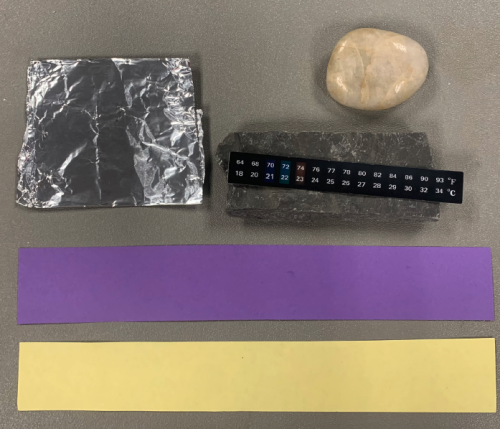How do reptiles warm or cool themselves?
Ages: 5-8 years
Time Required: 30-120 minutes
Basking Basics Activity Instructions
 Materials
Materials
- Aluminum foil
- Strip of dark paper
- Strip of light paper
- Light colored rock
- Dark colored rock
- Flat sticker thermometer (like one used for aquariums or placed on baby foreheads)
- Pencil
Try This!
Step 1: Use the chart to record what you learn.
Step 2: Place a sheet of aluminum foil, a light strip of paper, a dark paper, a light colored rock, and a dark colored rock on a table indoors. After for 10 minutes, touch each item to see how it feels to you. Next measure the temperature. Use the flat liquid thermometer in your museum kit. Record the results in your chart.
Step 3: Place the items outdoors in a sunny area for 10 minutes. This mimics the environment shortly after sunrise. Repeat observations and data collection.
Step 4: Leave the items in the sun for two hours. Repeat observations and data collection.
Step 5: Remove the items from the sun and let sit for 10 minutes. This mimics the environment shortly after sunset. Repeat the observations and data collection one final time.
Step 6: Questions—Is your sense of touch an accurate way to measure temperatures? Did all the items warm up and cool down at the same rate? If you were a reptile, where would be the best place to warm up when the sun is coming up? After the sun has set?
What’s going on?
Reptiles must move to warmer or cooler areas to reach their ideal body temperatures. That is why they are called ectotherms. Ectotherm animals cannot regulate their own body temperatures, like we can. Their body temperatures are controlled by the outside temperature of the water, ground or air where they are. Stretching out on a dark rock is a good way to get warm in a hurry!
Humans on the other hand and all mammals are endotherms, since we can regulate our own internal body temperatures independently from the environment. The average human body temperature is around 98.6 Fahrenheit or 37 Centigrade, and our bodies are pretty capable of maintaining that temperature even when we are in much colder environments, at least for a longer period of time when compared to an ectotherm if the temperatures are extremely cold.
Extension Activity
Try going outdoors and observing reptiles in their natural environment! Use iNaturalist.org to discover what reptiles you can find around you. Once you see a reptile take some notes of the habitats where you found them and the temperature of substrate where they were laying on. For example, if you see a lizard on a fence post, wait for the lizard to move along and using your flat thermometer take the temperature of the fence post near where you think the lizard was. See if objects that are made of different materials have different temperatures, and keep in mind that this could also vary depending on the time of day. Please remember to not disturb the animals, if they don’t move along try returning to the same place at the same time on the next day to take the temperatures.